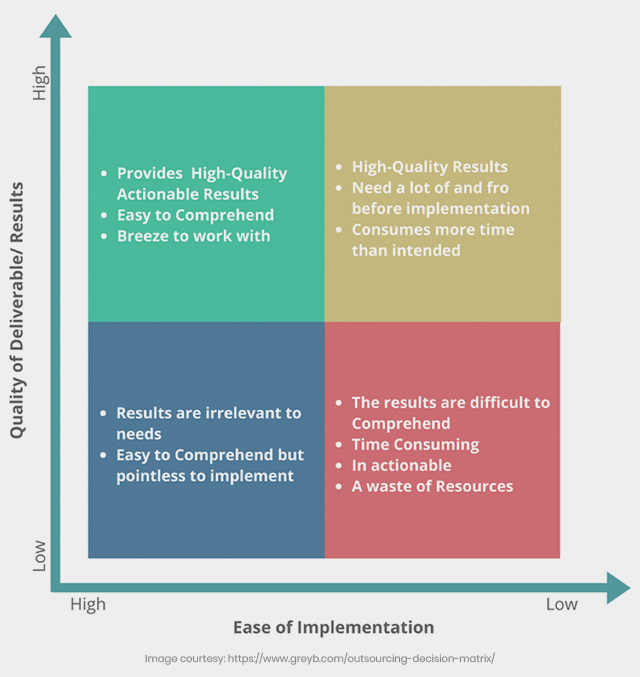Explaining the outsourcing decision matrix

Learning & Development
272 week ago — 7 min read
Background: When a business owner decides to outsource some work, the selection of a suitable service provider becomes critical. Shaunvir Mahil explains how the outsourcing decision matrix can assist in choosing the ideal service provider.
Outsourcing certain tasks in business can be beneficial for organisations in several ways. Outsourcing helps reduce overheads, brings in a new perspective to one’s business, gives businesses enough of free time to innovate and to carry out several other important tasks. Risks involved in outsourcing include losing control over proprietary information and ending up with products/services that disappoint from a quality point of view. These are perils one has to live with, though must not deter businesses to outsource tasks that deserve to be.
The outsourcing decision matrix is very helpful while selecting vendors. Amongst myriad vendors, the biggest predicament becomes which vendor to choose? It is very important that the vendor best suited to one’s needs must be chosen as only he can deliver desirable results. The outsourcing decision matrix helps come out of this state of decision paralysis.
The parameters of the outsourcing decision matrix are listed in such a way that businesses will find it easy to classify vendors into various quadrants depending on the traits they exhibit. After classifying the vendors, it will become easy to finalise the vendor who fits the requirement best and can help the business achieve set objectives.
Also read: Why are companies outsourcing data analytics?
Given below is a graphical representation of the outsourcing decision matrix

The first quadrant or quadrant one, classifies those vendors offering high-quality results. The results begin to show fast and the vendors become a treat to work with. Communication from their side is so smooth that you start enjoying the process.
The second quadrant or quadrant two has those vendors listed in it who offer high-quality results but consume a lot of time and energy whilst doing so. With these kind of vendors, results are not that easy to come, though they do eventually only after several follow-throughs and multiple rounds of cross-questioning as to how the results fit one’s business needs.
The third quadrant or quadrant three lists vendors who offer results of low quality and make it quite evident that they least suit your business needs, even though communication with them is of acceptable standards.
Vendors classified under the fourth quadrant or quadrant four are the ones delivering lowest-quality results, least enjoyable experiences and worst experiences. As a matter of fact, the experiences are so bad that you would not even wish for anyone else to have such experiences.
What is the decision making criteria?
It only makes sense that you choose a vendor demonstrating all the qualities mentioned in quadrant one.
A closer look at the quadrant makes it evident that vendors spoken of are either those offering high-quality service or low-quality service. There are no medium-quality vendors. The million dollar question here, what is one’s definition of quality? To put it forth, there is no such thing as medium-quality where one settles for something mediocre which seems workable for the meanwhile. The results either have the quality which satisfy you or simply do not have it leaving you fuming.
What were your set expectations from your service provider? It is easy to blame the vendor later on, but are your own expectations reasonable? An example of a management software will be ideal where the organisation seeking a vendor confronts four different scenarios.
- The vendor offers a solution that suffices your business requirement. You find it scalable, the results measurable and easy to track metrics. It is transparent to all shareholders and the solution delivered is very easy to use. Undoubtedly, this falls into quadrant one and is the most desirable solution for you.
- The vendor offers a solution with exciting features to measure results and convey the progress made but to install the solution, your current hardware offers no compatibility. It becomes clear to you that a change in hardware is mandatory if the solution is to be used. This kind of solution falls into the second quadrant by virtue of offering good features though warranting a change in systems. But at the end of the day, it does answer your business questions. Just because it falls in the second quadrant does not mean it won’t work for you. An upgrade can be very rewarding in the longer run.
- The vendor offers a solution capable of tracking metrics but unable to offer a quantitative measure of results. Moreover, stakeholders find the processes opaque and effortlessly conclude it to be a low-quality result, the solution eventually warranting a place in the third quadrant.
- The vendor offers a content-centric solution and one that supports integration, though the requirement was of a data-centric and workflow-oriented solution. So now the vendor expects you to upgrade your current hardware and has accounted for a terrible experience. The moral of the story is that quality is a very subjective term that depends on your expectations from the service provider.
Also read: How your past can affect your future with the decisions you make today
How does one implement the outsourcing decision matrix?
While finalising a vendor, several factors come into play and the outsourcing decision matrix helps tackle with these. Using it helps make informed decisions, better decisions and sensible decisions. Given below are steps that make it easy to use the outsourcing decision matrix to make wise decisions:
Step 1: Identify the vendors you feel are best suited to handle your task.
Step 2: Find out how soon they can deliver, whether the delivered solution will be measurable, have acceptance with shareholders and with what time frame it will be delivered. Also find out whether the solution proposed by a prospective vendor warrants any changes at your end, structural or administrative. Also find out whether the solution delivered will be tangible or not. Measure what kind of communication you enjoy with the vendor.
Step 3: Plot the task in the matrix and you have your answer, as to what kind of vendor would be best suited for you. Outsource accordingly.
When confusions engulf your mind, uncertainty clouds your judgment and indecisiveness plagues your decision-making ability, the outsourcing decision matrix comes to your rescue and helps you take wise, sane and productive decisions while outsourcing work.
Image source: shutterstock.com
To explore business opportunities, link with me by clicking on the 'Connect' button on my eBiz Card.
Disclaimer: The views and opinions expressed in this article are those of the author and do not necessarily reflect the views, official policy or position of GlobalLinker.
Posted by
Shaunvir Singh MahilShaun is the Director of Virtual Employee Private Limited, a remote staffing & tech MNC, and is responsible for leading a team of more than 1200 experts from domains like IT,...
View Shaunvir 's profile
Other articles written by Shaunvir Mahil
Most read this week
Trending
Ecommerce 26 Mar 2025











Comments
Share this content
Please login or Register to join the discussion